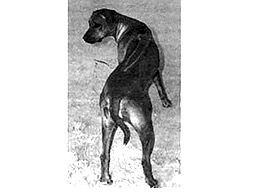About the Ridgeback
Like all purebred dogs, the Ridgeback must conform to a Breed Standard as below.
In addition to this an Extended Breed Standard provides more information.
If you are interested in the breed the club has put together this paper for potential puppy buyers.
A breed standard is the guideline which describes the ideal characteristics, temperament, and appearance of a breed and ensures that the breed is fit for function with soundness essential. Breeders and judges should at all times be mindful of features which could be detrimental in any way to the health, welfare or soundness of this breed.

|
Group: |
Group 4 (Hounds) |
|
History: |
The Rhodesian Ridgeback is presently the only registered breed indigenous to Southern Africa. Its forebears can be traced to Cape Colony of Southern Africa where they crossed with the early pioneers’ dogs and the semi-domesticated, ridged Hottentot hunting dogs. Hunting mainly in groups of two or three, the original function of the Rhodesian Ridgeback or Lion dog was to track game, especially lion, and, with great agility, keep it at bay until the arrival of the hunter. |
|
General Appearance: |
The Rhodesian Ridgeback should represent a well balanced, strong, muscular, agile and active dog, symmetrical in outline and capable of great endurance with a fair amount of speed. The emphasis is on agility, elegance and soundness with no tendency towards massiveness. The peculiarity of the breed is the ridge on the back, which is formed by the hair growing in the opposite direction to the rest of the coat. |
|
Characteristics: |
The ridge is the escutcheon of the breed. The ridge must be clearly defined, symmetrical and tapering towards the haunch. It must start immediately behind the shoulders and continue to the hip (haunches) bones. The ridge must contain only two crowns, identical and opposite each other. The lower edges of the crowns must not extend further down the ridge than one-third of its length. A good average width of the ridge is 5 cm (2ins). |
|
Temperament: |
Dignified, intelligent, aloof with strangers, but showing no aggression or shyness. |
|
Head And Skull: |
Cranial Region: Skull - Should be of a fair length (width of head between ears, distance from occiput to stop, stop to end of nose, should be equal), flat and broad between the ears; the head should be free from wrinkles when in repose. |
|
Eyes: |
Should be moderately well apart, round, bright and sparkling, with intelligent expression, their colour harmonising with the colour of the coat. |
|
Ears: |
Should be set rather high, of medium size, rather wide at base and gradually tapering to a rounded point. They should be carried close to the head. |
|
Mouth: |
Jaws strong with a perfect and complete scissor bite, i.e. the upper teeth closely overlapping the lower teeth and set square to the jaws. The teeth must be well developed, especially the canines or holders. |
|
Neck: |
Should be fairly long, strong and free from throatiness. |
|
Forequarters: |
The forelegs should be perfectly straight, strong and well boned, with the elbows close to the body. When viewed from the side, the forelegs should be wider than viewed from the front. Pasterns should be strong with slight spring. |
|
Body: |
Back - Powerful. |
|
Hindquarters: |
In the hind legs the muscles should be clean and well defined with good turn of stifle and strong hocks well let down. |
|
Feet: |
Should be compact and round with well arched toes and tough, elastic pads, protected by hair between the toes and pads. |
|
Tail: |
Should be strong at the root and gradually tapering towards the end, free from coarseness. It should be of moderate length. It should not be attached too high nor too low and should be carried with a slight curve upwards, never curled. |
|
Gait/Movement: |
Straight forward, free and active. |
|
Coat: |
Hair - Should be short and dense, sleek and glossy in appearance but neither woolly nor silky. |
|
Colour: |
Light wheaten to red wheaten. A little white on the chest and toes is permissible, but excessive white hairs here, on belly or above toes is undesirable. A dark muzzle and ears permissible. Excessive black hairs throughout the coat are highly undesirable. |
|
Sizes: |
The desirable heights are: |
|
Faults: |
Any departure from the foregoing points should be considered a fault and the seriousness with which the fault should be regarded should be in exact proportions to its degree. |
|
Notes: |
Male animals should have two apparently normally developed testicles fully descended into the scrotum. |
|
|
|
|
|